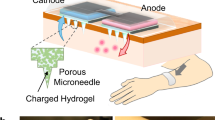Abstract
A programmable, skin-attached, 36 × 30 × 8 mm system for subcutaneous infusion of 1.2 mL of a drug solution is described. The system is intended to be replaced daily. It comprises a 20 × 14 × 8 mm electronic controller and power source, an 8 mm diameter 2 mm thick electroosmotic pump, a two-compartment reservoir for a pumped water and a drug solution, an adhesive tape for attachment to the skin, and a 6 mm long 27 gauge needle. Its removable electronic controller programs the dose rate and dose and is re-used. The electroosmotic pump consists of a porous ceramic membrane sandwiched between a pair of Ag/Ag2O plated carbon paper electrodes. It operates below 1.23 V, the thermodynamic threshold for water electrolysis without gassing. The flow rate can be adjusted between 4 and 30 μL min−1 by setting either by the voltage (0.2–0.8 V) or the current (30–200 μA). For average flow rates below 4 μL min−1, the pump is turned on and off intermittently. For example, a flow rate of 160 μL day−1, i.e., 0.13 μL min−1 for basal insulin infusion in type 1 diabetes management, is obtained when 10 s pulses of 75 μA is applied every 15 min. High flow rates of 10–30 μL min−1, required for prandial insulin administration, are obtained when the pump operates at 50–200 μA. To prevent fouling by the drug, only pure water passes the pump; the water pushes a drop of oil, which, in turn, pushes the drug solution.







Similar content being viewed by others
References
Alsaleh FM, Smith FJ, Keady S, Taylor KMG. Insulin pumps: from inception to the present and toward the future. J Clin Pharm Ther. 2010;35:127–38.
Chen L, Lee S, Choo J, Lee EK. Continuous dynamic flow micropumps for microfluid manipulation. J Micromech Microeng. 2008;18:1–22.
Evans AT, Park JM, Chiravuri S, Gianchandani YB. A low power, microvalve regulated architecture for drug delivery systems. Biomed Microdev. 2010;12:159–68.
Kim D, Posner JD, Santiago JG. High flow rate per power electroosmotic pumping using low ion density solvents. Sens Actuators A. 2008;A141:201–12.
Litster S, Suss ME, Santiago JG. A two-liquid electroosmotic pump using low applied voltage and power. Sens Actuators A. 2010;A163:311–4.
NFT Electro-Osmotic Pumps. NanoFusion-Technologies, Tokyo. 2010. http://www.nft-eop.co.jp/en/index.html.
Nie F-Q, Macka M, Barron L, Connolly D, Kent N, Paull B. Robust monolithic silica-based on-chip electro-osmotic micro-pump. Analyst. 2007;132:417–24.
Paudel KS, Milewski M, Swadley CL, Brogden NK, Ghosh P, Stinchcomb AL. Challenges and opportunities in dermal/transdermal delivery. Ther Delivery. 2010;1:109–31.
Potti LG, Haines ST. Continuous subcutaneous insulin infusion therapy: a primer on insulin pumps. J Am Pharm Assoc. 2009;49:e1–13. quiz e4–7.
Prausnitz MR, Langer R. Transdermal drug delivery. Nat Biotechnol. 2008;26:1261–8.
Shin W, Lee JM, Nagarale RK, Shin SJ, Heller A. A miniature, non-gassing electroosmotic pump operating at 0.5 V. J Am Chem Soc. 2011;133:2374.
Tsai NC, Sue CY. Review of MEMS-based drug delivery and dosing systems. Sens Actuators A. 2007;134:555–64.
Acknowledgments
We thank SD Kim of KS RnD, Korea for designing the electronic module. AH and RJK thank the Welch Foundation (grant # 1131).
Author information
Authors and Affiliations
Corresponding authors
Additional information
This study was performed at the University of Texas, Austin, while WS and JML were on leave from the Sogang University.
Rights and permissions
About this article
Cite this article
Shin, W., Shin, S.J., Lee, J.M. et al. A miniature, single use, skin-adhered, low-voltage, electroosmotic pumping-based subcutaneous infusion system. Drug Deliv. and Transl. Res. 1, 342–347 (2011). https://doi.org/10.1007/s13346-011-0021-7
Published:
Issue Date:
DOI: https://doi.org/10.1007/s13346-011-0021-7




